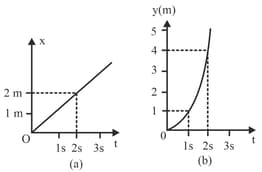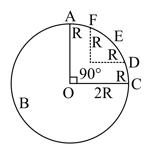A gun fires a ball of 1kg horizontally from a cliff of height . It falls on the ground at a distance of from the bottom of the cliff. Find the recoil velocity of the gun. (acceleration due to gravity)

Important Questions on Laws of Motion
Figure and shows diagram of a particle moving in dimensions If the particle has a mass of , find the force (direction and magnitude) acting on the particle.

A person in an elevator accelerating upwards with an acceleration of , tosses a coin vertically upwards with a speed of . After how much time will the coin fall back into his hand?
Figure and shows and diagrams for a body of unit mass. Find the force, as a function of time.

A racing car travels on a track (without banking) (Figure). is a circular arc of radius . and are straight paths of length and is a circular arc of radius . The coefficient of friction on the road is . The maximum speed of the car is . Find the minimum time for completing one round.

The displacement vector of a particle of mass is given by
Show that the trajectory is an ellipse.
The displacement vector of a particle of mass $m$ is given by
Show that
